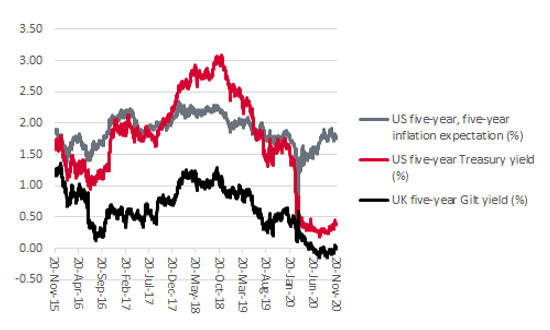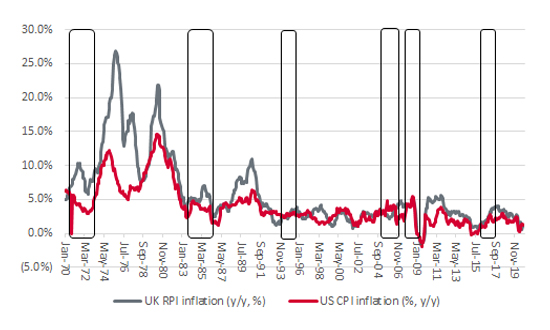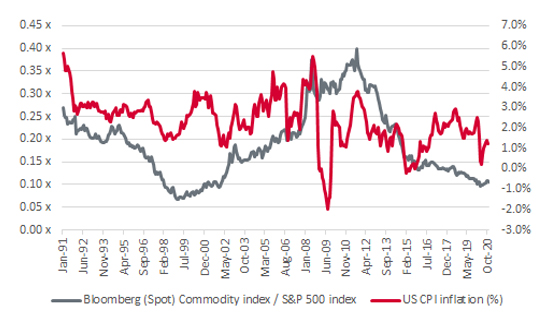


One of the fiercest debates of 2020, at least when it comes to the narrow confines of investment strategy rather than the wider issue of public health, remains whether inflation, stagflation or deflation will be one result of the pandemic and, arguably, some of the policies deployed in response to it.
No one, but no one, knows the ultimate outcome – not even central bankers, who, if they did, would not be still using and tweaking policies that were called unorthodox and exceptional when they were launched over a decade ago in further efforts to generate the inflation they seemingly crave.
All investors can do is watch out for possible signs that inflation or deflation is on the way and keep an open mind.
“Judging by yields of 0.38% on the US five-year Treasury bond and 0.02% on the UK five-year gilt, bond markets remain of the view that deflation continues to be the main danger to advisers’ and clients’ portfolios but commodity markets seem to have a different view.”
Judging by yields of 0.38% on the US five-year Treasury bond and 0.02% on the UK five-year gilt, bond markets remain of the view that deflation continues to be the danger, or at least that suggests that the next few years are going to be similar to the last 10 or so – namely low growth, low inflation and low interest rates.
Such an environment has proved a fertile breeding ground for long-duration assets such as technology, biotechnology and ‘growth’ stocks, as well as bonds, but harder work for shorter-duration assets such as cyclical, or ‘value’ equities and commodities.
Inflation expectations still exceed bond yields (but they are no longer rising)

Source: Refinitiv data
Yet not everyone is convinced. Five-year-forward inflation expectations are hovering around 1.8% and, if that proves right, then developed-market government bonds offer relatively little protection even from that. Inflation expectations are not rising, at least for the moment, but it will be interesting to see if they are influenced by commodity prices, which are ticking higher once more.
Even a casual glance at the newspapers or newswires will gave a flavour of the action in commodity markets.
The Bloomberg Commodities index stands near two-year highs

Source: Refinitiv data
The net result is that the Bloomberg Commodity index overall is nearing the peak of 2018 and thus bearing down on levels last seen before that in 2014.
“The Bloomberg Commodity index is nearing the peak of 2018 and thus bearing down on levels last seen before that in 2014. The question now is whether rising raw materials costs for companies and rising food costs for consumers will lead to inflation (or not).”
The question now is whether this is a trend or not and whether rising raw materials costs for companies and rising food costs for consumers will lead to inflation, should the former jack up their prices to protect profit margins and the latter demand pay rises to help them meet the higher cost of living. In such an uncertain economic environment as the current one, few firms or consumers may be willing to chance their arm, it must be said. But in a post-vaccine world, the picture could look very different, emboldening both.
It is tempting to argue that the increase in copper and iron ore prices is one indication that an economic upturn is on the way, thanks to fiscal and monetary stimulus programmes the world over, expectations that a vaccine is on the way and hopes that 2021 will be a better place all round.
The food price increases may not be quite so conclusive and could just as easily be the result of the La Niña weather pattern which is in evidence this year. This complex meteorological feature occurs relatively rarely – America’s National Oceanic and Atmospheric Administration says this is just the seventh incidence since 1970 – but it can lead to below-average rainfall in Peru and Chile, East Africa and southwestern America but storms and floods in Brazil, Southern Africa, Australia and Asia.
Investors have enough imponderables to face without having to think about the weather and second-guessing such near-term patterns really would be a mug’s game, especially since inflation in America accelerated during only two of the last six La Niña patterns, even if it did so five times in the UK.
La Niña weather patterns do not have a clear influence on inflation on both sides of the Atlantic

Source: Refinitiv data
“Having massively outperformed equities in the first decade of this millennium, commodities were huge laggards in the second. Whether we are on the cusp of one of those once-in-a-decade shifts that has huge ramifications for asset allocation and equity and fund selection remains to be seen.”
Nevertheless, it should be informative to see how the Bloomberg Commodity index fares. Having massively outperformed equities in the first decade of this millennium, commodities were huge laggards in the second.
Is the Bloomberg Commodity index starting to outperform the S&P 500 once more?

Source: Refinitiv data
Whether we are on the cusp of one of those once-in-a-decade shifts that has huge ramifications for asset allocation and equity and fund selection remains to be seen, but commodity prices do not, for the moment at least, share the bond market’s conviction that the next five to ten years are going to see the same economic backcloth as the last five to ten.
This area of the website is intended for financial advisers and other financial professionals only. If you are a customer of AJ Bell Investcentre, please click ‘Go to the customer area’ below.
We will remember your preference, so you should only be asked to select the appropriate website once per device.